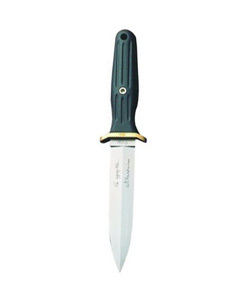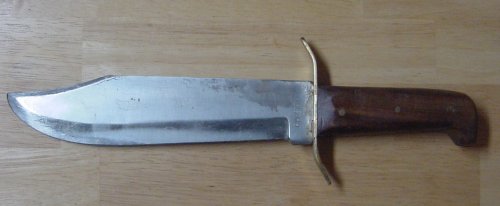|
Blade (magazine)
''Blade'' is a consumer magazine about knife collecting. The magazine is based in Appleton, Wisconsin. History and profile First published in 1973 under the title ''American Blade'' by Southern House Publishing Co. with Blackie Collins as the editor. The headquarters was in Chattanooga, Tennessee. The magazine's title was changed to ''Blade'' in 1982 after its purchase by Jim Parker and Bruce Voyles. In the 1980s, the magazine served as the launching point for an annual convention for knife collectors, the Blade Show; established a Cutlery Hall of Fame; and spun off a trade magazine, '' Blade Trade''. In 1994, Voyles, then the sole owner, sold the publication and its properties to Krause Publications, which increased its frequency to monthly. F+W Publications Inc. purchased Krause Publications and ''Blade'' in 2002 and published it under its brand beginning in October 2004. In 2018, Gun Digest Media LLC acquired ''Blade'', Blade Show and all related properties. Coverage in the ... [...More Info...] [...Related Items...] OR: [Wikipedia] [Google] [Baidu] |
Knife
A knife ( : knives; from Old Norse 'knife, dirk') is a tool or weapon with a cutting edge or blade, usually attached to a handle or hilt. One of the earliest tools used by humanity, knives appeared at least 2.5 million years ago, as evidenced by the Oldowan tools. Originally made of wood, bone, and stone (such as flint and obsidian), over the centuries, in step with improvements in both metallurgy and manufacturing, knife blades have been made from copper, bronze, iron, steel, ceramic, and titanium. Most modern knives have either fixed or folding blades; blade patterns and styles vary by maker and country of origin. Knives can serve various purposes. Hunters use a hunting knife, soldiers use the combat knife, scouts, campers, and hikers carry a pocket knife; there are kitchen knives for preparing foods (the chef's knife, the paring knife, bread knife, cleaver), table knives (butter knives and steak knives), weapons (daggers or switchblades), knives for throwing or juggling, a ... [...More Info...] [...Related Items...] OR: [Wikipedia] [Google] [Baidu] |
Jimmy Lile
James Buel Lile (August 22, 1933 – May 5, 1991), known as Jimmy Lile and "The Arkansas Knifesmith", was an American knifemaker from Russellville in Pope County, Arkansas, who made the Rambo Knife for the films ''First Blood'' and '' Rambo: First Blood Part II''. As a knifemaker Lile served as a president of the Knifemakers' Guild and on the board of directors of the American Bladesmith Society. Early life A Russellville native, Lile was the son of a coal miner. He made his first knife at the age of eleven by grinding an old file into a blade. He spent his young adult life working as a high school teacher, serving in the United States Army, and as a construction contractor. Knifemaker In 1971, Lile became a full-time knifemaker and was known as "Gentleman Lile" or "The Arkansas Knifemaker". He was particularly known for his Survival knife designs known as "The Mission" series, created by request for Sylvester Stallone to use in his first two ''Rambo'' movies. These des ... [...More Info...] [...Related Items...] OR: [Wikipedia] [Google] [Baidu] |
Spyderco
Spyderco is an American cutlery company based in Golden, Colorado, producing knives and knife sharpeners. Spyderco pioneered many features that are now common in folding knives, including the pocket clip, serrations, and the opening hole. Spyderco has collaborated with 30 custom knife makers, athletes, and self-defense instructors for designs and innovated the usage of 20 different blade materials. History Spyderco was founded by Sal Glesser. The name Spyderco was coined after Glesser noticed that many high performance sports cars had 'Spyder' in the name; which inspired the name Spyderco to signify high performance cutting tools. The first product Spyderco produced was the Portable Hand in 1976, this "spider-shaped device", was a series of angles, ball joints and alligator clips that helped people such as jewelers and hobbyists to work with small parts. Spyderco's founder, Sal Glesser, and his wife Gail, converted an old bread delivery truck into a motor-home and traveled to s ... [...More Info...] [...Related Items...] OR: [Wikipedia] [Google] [Baidu] |
Frank Centofante
Frank or Franks may refer to: People * Frank (given name) * Frank (surname) * Franks (surname) * Franks, a medieval Germanic people * Frank, a term in the Muslim world for all western Europeans, particularly during the Crusades - see Farang Currency * Liechtenstein franc or frank, the currency of Liechtenstein since 1920 * Swiss franc or frank, the currency of Switzerland since 1850 * Westphalian frank, currency of the Kingdom of Westphalia between 1808 and 1813 * The currencies of the German-speaking cantons of Switzerland (1803–1814): ** Appenzell frank ** Argovia frank ** Basel frank ** Berne frank ** Fribourg frank ** Glarus frank ** Graubünden frank ** Luzern frank ** Schaffhausen frank ** Schwyz frank ** Solothurn frank ** St. Gallen frank ** Thurgau frank ** Unterwalden frank ** Uri frank ** Zürich frank Places * Frank, Alberta, Canada, an urban community, formerly a village * Franks, Illinois, United States, an unincorporated community * Franks, Missouri, United Sta ... [...More Info...] [...Related Items...] OR: [Wikipedia] [Google] [Baidu] |
Rex Applegate
Rex Applegate (June 21, 1914 – July 14, 1998) was an American military officer who worked for the Office of Strategic Services, where he trained Allied special forces personnel in close-quarters combat during World War II. He held the rank of colonel. Early life Applegate was born on June 21, 1914, in Oregon. He was a descendant of Charles Applegate, who blazed the Oregon Trail in 1843 with his brothers Jesse and Lindsay and established the Applegate Trail. Applegate began hunting and shooting at a young age and learned marksmanship from his uncle Gus Peret who was a famed exhibition shooter and professional hunter at the time. Applegate graduated from the University of Oregon with a Business Degree in 1940 and went on to take a commission in the US Army as a second lieutenant. His first billet was with the 209th Military Police Company as a lung ailment kept him from holding a combat position. World War II In 1941, Applegate was developing armed and unarmed close quarter c ... [...More Info...] [...Related Items...] OR: [Wikipedia] [Google] [Baidu] |
Buster Warenski
Buster Warenski (June 5, 1942 – July 31, 2005) was an American custom knifemaker from Kimberly, Nevada who made "Art Knives" utilizing gold and other precious metals. Warenski is best known for making a reproduction of King Tut's dagger with a forged gold blade; over 32 ounces of gold were used in the construction of the dagger, making it one of the most valuable knives made in recent years. Knifemaking career Warenski began making knives as a hobby in 1966 after seeing a picture of a knife made by Gil Hibben. Warenski made his first knife from a file and took it to show Hibben; after seeing Hibben's finished knives, he toured Hibben's shop and learned some basic techniques from him. In June 1972 he was hired by Harvey Draper to grind blades and assist him at Draper Knives, but the operation went bankrupt by December of the same year. Warenski became a full-time knifemaker in 1975. He was a president of the Knifemakers' Guild for 2 terms and a ''Blade'' Magazine member of the Cut ... [...More Info...] [...Related Items...] OR: [Wikipedia] [Google] [Baidu] |
Gil Hibben
Gil Hibben (born September 4, 1935) is an American custom knifemaker from Wyoming who is based in La Grange, Kentucky. Hibben designed the first line of Browning hunting knives in 1968, the American Kenpo Knife for Ed Parker, and the Rambo Knife for the films ''Rambo III'' and ''Rambo''. Hibben's "Fantasy Knives" have been used in over 37 films and television shows, particularly science fiction, earning him the title "Klingon Armorer" from the ''Star Trek'' franchise. Hibben currently serves as a President of the Knifemakers' Guild, a post he has held for fourteen years. Early life Hibben was born in Wyoming in 1935. Unable to afford a Bowie knife at age 15, Hibben decided to make his own out of scrap metal and files. He did not make another knife until his discharge from the US Navy in 1956 when he took a job in Seattle, Washington as a machinist for Boeing Aircraft and started making knives in his spare time after he sold another handmade Bowie knife to a friend for $45 ... [...More Info...] [...Related Items...] OR: [Wikipedia] [Google] [Baidu] |
William Scagel
William Wales Scagel or Bill Scagel (February 12, 1873 – March 26, 1963) was an American knifemaker whose style had a profound impact on the cutlery trade, influencing it for over 100 years. Early life Born near Alpena, Michigan and raised in Canada, Scagel began making knives in 1910 while working at lumber camps throughout Michigan and Canada. Prior to this he worked as a bridgebuilder and an artist in wrought iron. In 1920, after his shop in Muskegon, Michigan burned down he settled in nearby Fruitport and built a new shop on a piece of land he named "Dogwood Nub" which began his long full-time career of making knives, axes, cookware, and boats. Knifemaking From 1920 through 1929, Scagel sold his knives through Abercrombie & Fitch of New York and their subsidiaries such as Von Lengerke & Antoine. Scagel made hunting knives, machetes, and axes for the expeditions of the Smithsonian Institution. Scagel made a variety of knives throughout his career including Bowie knives, f ... [...More Info...] [...Related Items...] OR: [Wikipedia] [Google] [Baidu] |
Jim Bowie
James Bowie ( ) ( – March 6, 1836) was a 19th-century American pioneer, slave smuggler and trader, and soldier who played a prominent role in the Texas Revolution. He was among the Americans who died at the Battle of the Alamo. Stories of him as a fighter and frontiersman, both real and fictitious, have made him a legendary figure in Texas history and a folk hero of American culture. Bowie was born in Kentucky. He spent most of his life in Louisiana, where he was raised and where he later worked as a land speculator. His rise to fame began in 1827 on reports of the Sandbar Fight near present-day Vidalia, Louisiana. What began as a duel between two other men deteriorated into a mêlée in which Bowie, having been shot and stabbed, killed the sheriff of Rapides Parish with a large knife. This, and other stories of Bowie's prowess with a knife, led to the widespread popularity of the Bowie knife. Bowie enlarged his reputation during the Texas Revolution. After moving to Te ... [...More Info...] [...Related Items...] OR: [Wikipedia] [Google] [Baidu] |
William F
William is a male given name of Germanic origin.Hanks, Hardcastle and Hodges, ''Oxford Dictionary of First Names'', Oxford University Press, 2nd edition, , p. 276. It became very popular in the English language after the Norman conquest of England in 1066,All Things William"Meaning & Origin of the Name"/ref> and remained so throughout the Middle Ages and into the modern era. It is sometimes abbreviated "Wm." Shortened familiar versions in English include Will, Wills, Willy, Willie, Bill, and Billy. A common Irish form is Liam. Scottish diminutives include Wull, Willie or Wullie (as in Oor Wullie or the play ''Douglas''). Female forms are Willa, Willemina, Wilma and Wilhelmina. Etymology William is related to the given name ''Wilhelm'' (cf. Proto-Germanic ᚹᛁᛚᛃᚨᚺᛖᛚᛗᚨᛉ, ''*Wiljahelmaz'' > German ''Wilhelm'' and Old Norse ᚢᛁᛚᛋᛅᚼᛅᛚᛘᛅᛋ, ''Vilhjálmr''). By regular sound changes, the native, inherited English form of the name shoul ... [...More Info...] [...Related Items...] OR: [Wikipedia] [Google] [Baidu] |





